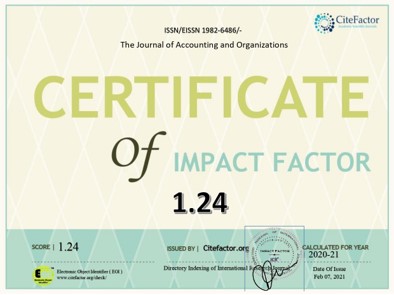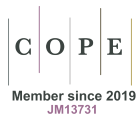Efeitos da concentração de propriedade e da estrutura do conselho de administração nos covenants de debêntures emitidas pelas empresas brasileiras de capital aberto
DOI:
https://doi.org/10.11606/issn.1982-6486.rco.2019.158820Palavras-chave:
Debêntures, Concentração de propriedade, Conselho de administração, CovenantsResumo
Este estudo objetiva identificar fatores da governança corporativa que afetam a quantidade de covenants financeiros presentes nos contratos de debêntures e a restrição advinda do covenant financeiro “Dívida Financeira Líquida/EBITDA”. Os dados foram analisados por meio de regressões múltipla e logística e os resultados indicam que a concentração de propriedade e o tamanho do conselho de administração são determinantes para definir o número de covenants financeiros inseridos nos contratos das debêntures emitidas. Além disso, os resultados apontam que a concentração de propriedade, o tamanho e a independência do conselho de administração influenciam a probabilidade de a escritura de emissão de debênture conter um covenant financeiro “Dívida Financeira Líquida/EBITDA” mais ou menos restritivo. Como contribuição, este trabalho mostra que as empresas emissoras de debêntures podem procurar mecanismos substitutos à utilização e à restrição de covenants financeiros e, assim, evitar os entraves decorrentes dessas cláusulas contratuais, e fornece apoio à literatura de que mecanismos internos de governança corporativa impactam tanto a quantidade de covenants financeiros quanto a restrição imposta pelo covenant de endividamento em contratos de debêntures.
Downloads
Referências
current theorising. Accounting, Auditing & Accountability Journal, 15(2), 223-250. DOI: https://doi.
org/10.1108/09513570210418905
Al‐Najjar, B. (2015). The Effect of Governance Mechanisms on Small and Medium‐Sized Enterprise Cash
Holdings: Evidence from the United Kingdom. Journal of Small Business Management, 53(2), 303-320.
DOI: https://doi.org/10.1111/jsbm.12062
Anderson, R. C., Mansi, S. A., & Reeb, D. M. (2004). Board characteristics, accounting report integrity, and
the cost of debt. Journal of Accounting and Economics, 37(3), 315-342. DOI: https://doi.org/10.1016/j.
jacceco.2004.01.004
Associação Brasileira das Entidades dos Mercados Financeiros e de Capitais - Anbima. Introdução às debêntures.
Recuperado de: <http://www.debentures.com.br/espacodoinvestidor/introducaoadebentures.asp>
Ball, R., Kothari, S. P., & Robin, A. (2000). The effect of international institutional factors on properties of
accounting earnings. Journal of accounting and economics, 29(1), 1-51. DOI: https://doi.org/10.1016/S0165-
4101(00)00012-4
Barclay, M. J., & Smith Jr, C. W. (1995). The maturity structure of corporate debt. The Journal of Finance, 50(2),
609-631. DOI: https://doi.org/10.1111/j.1540-6261.1995.tb04797.x
Bebchuk, L. A., Kraakman, R., & Triantis, G. (2000). Stock pyramids, cross-ownership, and dual class equity:
the mechanisms and agency costs of separating control from cash-flow rights. In Concentrated corporate
ownership (pp. 295-318). University of Chicago Press.
Berger, A. N., & Udell, G. F. (1995). Relationship lending and lines of credit in small firm finance. Journal of
Business, 351-381.
Berlin, M., & Mester, L. J. (1992). Debt covenants and renegotiation. Journal of Financial Intermediation, 2(2),
95-133. DOI: https://doi.org/10.1016/1042-9573(92)90005-X
Bhagat, S., & Black, B. (2000). Board independence and long-term firm performance. Unpublished Paper,
University of Colorado.
Bos, A. D., & Donker, H. (2004). Monitoring accounting changes: empirical evidence from the Netherlands.
Corporate Governance: An International Review, 12(1), 60-73. DOI: https://doi.org/10.1111/j.1467-
8683.2004.00343.x
Bradley, M., & Roberts, M. R. (2015). The structure and pricing of corporate debt covenants. The Quarterly
Journal of Finance, 5(02), 1550001-37. DOI: http://dx.doi.org/10.2139/ssrn.585882
Brandão, I. F., Vasconcelos, A. C., Luca, M. M. M., & Crisóstomo, V. L. (2019). Composição do Conselho de
Administração e Sensibilidade da Remuneração Executiva ao Desempenho de Mercado. Revista Contabilidade
& Finanças - USP, 30(79), 28-41. DOI: https://doi.org/10.1590/1808-057x201806610
Central de Custódia e Liquidação Financeira de Títulos Privados - Cetip. Títulos de dívida corporativa crescem
47% em 2017. Recuperado de: <https://www.cetip.com.br/Noticias/Titulos-de-dívida-corporativa-crescem-
47-em-2017>
Coles, J. L., Daniel, N. D., & Naveen, L. (2008). Boards: Does one size fit all?. Journal of Financial Economics,
87(2), 329-356. DOI: https://doi.org/10.1016/j.jfineco.2006.08.008
Correia, L. F., Amaral, H. F., & Louvet, P. (2011). Um índice de avaliação da qualidade da governança corporativa
no Brasil. Revista Contabilidade & Finanças, 22(55), 45-63. DOI: https://doi.org/10.1590/S1519-
70772011000100004
Cunha, V., & Rodrigues, L. L. (2018). Determinantes da Divulgação de Informação sobre a Estrutura de
Governança das Empresas Portuguesas. Revista Brasileira de Gestão de Negócios, 20(3), 338-360. DOI:
https://doi.org/10.7819/rbgn.v0i0.3359
Emira, H.; Amel, B. (2015). The determinants of bond covenants: the case of US firms. Euro-Asian Journal of
Economics and Finances, 3(3), 139-157.
Fama, E. F., & Jensen, M. C. (1983). Separation of ownership and control. The Journal of Law and Economics,
26(2), 301-325. https://www.jstor.org/stable/725104
Fávero, L. P., & Belfiore, P. (2017). Manual de análise de dados: estatística e modelagem multivariada com
Excel®, SPSS® e Stata®. Elsevier Brasil.
Fields, L. P., Fraser, D. R., & Subrahmanyam, A. (2012). Board quality and the cost of debt capital: The case of bank loans. Journal of Banking & Finance, 36(5), 1536-1547. DOI: https://doi.org/10.1016/j.jbankfin.2011.12.016
Jensen, M. C. (1993). The modern industrial revolution, exit, and the failure of internal control systems. The
Journal of Finance, 48(3), 831-880. DOI: https://doi.org/10.1111/j.1540-6261.1993.tb04022.x
Hong, H. A., Hung, M., & Zhang, J. (2016). The use of debt covenants worldwide: Institutional determinants and
implications on financial reporting. Contemporary Accounting Research, 33(2), 644-681. DOI: https://doi.
org/10.1111/1911-3846.12169
Klein, A. (2002a). Economic determinants of audit committee independence. The Accounting Review, 77(2), 435-
452. DOI: https://doi.org/10.2308/accr.2002.77.2.435
Klein, A. (2002b). Audit committee, board of director characteristics, and earnings management. Journal of
Accounting and Economics, 33(3), 375-400. DOI: https://doi.org/10.1016/S0165-4101(02)00059-9
Konraht, J. M. (2017). Determinantes da utilização dos covenants contábeis nas debêntures emitidas pelas
empresas listadas na BM&FBOVESPA. (Dissertação de Mestrado, Universidade Federal de Santa Catarina).
La Porta, R., Lopez-de-Silanes, F., Shleifer, A., & Vishny, R. (2000). Investor protection and corporate governance.
Journal of Financial Economics, 58(1-2), 3-27. DOI: https://doi.org/10.1016/S0304-405X(00)00065-9
La Porta, R., Lopez‐de‐Silanes, F., & Shleifer, A. (1999). Corporate ownership around the world. The Journal of
Finance, 54(2), 471-517. DOI: https://doi.org/10.1111/0022-1082.00115
Myers, S. C. (1977). Determinants of corporate borrowing. Journal of Financial Economics, 5(2), 147-175. DOI:
https://doi.org/10.1016/0304-405X(77)90015-0
Myers, S. C., & Majluf, N. S. (1984). Corporate financing and investment decisions when firms have information that investors do not have. Journal of Financial Economics, 13(2), 187-221. DOI: https://doi.org/10.1016/0304-
405X(84)90023-0
Nisiyama, E. K., & Nakamura, W. T. (2018). Diversidade do Conselho de Administração e a Estrutura de Capital.
Revista de Administração de Empresas, 58(6), 551-563. DOI: http://dx.doi.org/10.1590/S0034-759020180604
Paglia, J. K., & Mullineaux, D. J. (2006). An empirical exploration of financial covenants in large bank loans.
Banks and Bank Systems, 1(2), 103-122.
Paik, D. G. H., Smith, J. A. V. D L., Lee, B. B., & Yoon, S. W. (2015). The relation between accounting information
in debt covenants and operating leases. Accounting Horizons, 29(4), 969-996. DOI: https://doi.org/10.2308/
acch-51214
Park, C. (2000). Monitoring and structure of debt contracts. The Journal of Finance, 55(5), 2157-2195. DOI:
https://doi.org/10.1111/0022-1082.00283
Reisel, N. (2014). On the value of restrictive covenants: Empirical investigation of public bond issues. Journal of
Corporate Finance, 27, 251-268. DOI: https://doi.org/10.1016/j.jcorpfin.2014.05.011
Shivdasani, A., & Yermack, D. (1999). CEO involvement in the selection of new board members: An empirical
analysis. The Journal of Finance, 54(5), 1829-1853. DOI: https://doi.org/10.1111/0022-1082.00168
Singh, H., & Harianto, F. (1989). Management-board relationships, takeover risk, and the adoption of golden
parachutes. Academy of Management Journal, 32(1), 7-24. DOI: https://doi.org/10.5465/256417
Smith Jr, C. W., & Warner, J. B. (1979). On financial contracting: An analysis of bond covenants. Journal of
Financial Economics, 7(2), 117-161. DOI: https://doi.org/10.1016/0304-405X(79)90011-4
Stulz, R. (1988). Managerial control of voting rights: Financing policies and the market for corporate control.
Journal of Financial Economics, 20, 25-54. DOI: https://doi.org/10.1016/0304-405X(88)90039-6
Zou, H., Adams, M., & Xiao, J. Z. (2012). Does board independence matter for corporate insurance hedging?.
Journal of Financial Research, 35(3), 451-469. DOI: https://doi.org/10.1111/j.1475-6803.2012.01324.x
Publicado
Edição
Seção
Licença
A RCO adota a política de Acesso Livre (Libre Open Access), sob o acordo padrão Creative Commons (CC BY-NC-ND 4.0). O acordo prevê que:
- A submissão de texto autoriza sua publicação e implica compromisso de que o mesmo material não esteja sendo submetido a outro periódico. O original é considerado definitivo;
- Autores mantêm os direitos autorais e concedem à revista o direito de primeira publicação, com o trabalho simultaneamente licenciado sob a Licença Creative Commons Attributionque permite o compartilhamento do trabalho com reconhecimento da autoria e publicação inicial nesta revista;
- Autores têm autorização para assumir contratos adicionais separadamente, para distribuição não-exclusiva da versão do trabalho publicada nesta revista (ex.: publicar em repositório institucional ou como capítulo de livro), com necessário reconhecimento de autoria e publicação inicial nesta revista;
- Autores têm permissão e são estimulados a publicar e distribuir seu trabalho online (ex.: em repositórios institucionais ou na sua página pessoal) antes ou durante o processo editorial, já que isso pode gerar alterações produtivas, bem como aumentar o impacto e a citação do trabalho publicado (Veja O Efeito do Acesso Livre);
- A revista não paga direitos autorais aos autores dos textos publicados;
- O detentor dos direitos autorais da revista, exceto os já acordados no acordo de Libre Open Access (CC BY-NC-ND 4.0), é o Departamento de Contabilidade da Faculdade de Economia, Administração e Contabilidade de Ribeirão Preto da Universidade de São Paulo.
Não são cobradas taxas de submissão ou de publicação.
São aceitos até 4 autores por artigo. Casos excepcionais devidamente justificados poderão ser analisados pelo Comitê Executivo da RCO. São considerados casos excepcionais: projetos multi-institucionais; manuscritos resultantes da colaboração de grupos de pesquisa; ou que envolvam grandes equipes para coleta de evidências, construção de dados primários e experimentos comparados.
É recomendada a ordem de autoria por contribuição, de cada um dos indivíduos listados como autores, especialmente no desenho e planejamento do projeto de pesquisa, na obtenção ou análise e interpretação de dados e redação. Os autores devem declarar as efetivas contribuições de cada autor, preenchendo a carta ao editor, logo no início da submissão, responsabilizando-se pelas informações dadas.
É permitida a troca de autores durante todo o processo de avaliação e, antes da publicação do manuscrito. Os autores devem indicar a composição e ordem final de autoria no documento assinado por todos os envolvidos no aceite para publicação. Caso a composição e ordem de autoria seja diferente da informada anteriormente no sistema, todos autores anteriormente listados deverão se manifestar favoráveis.
No caso de identificação de autoria sem mérito ou contribuição (ghost, guest or gift authorship), a RCO segue o procedimento recomendado pela COPE.







